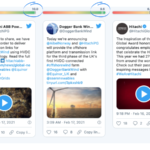Competitive analysis is not new – its importance can be traced back to the 16th century. The wealthy Fugger family of Germany published a newsletter containing firsthand information on events potentially impacting their family’s businesses. Their newsletters included competitor activities, political events, price of goods, and more. This was one of the earliest documented uses of competitor and marketing intelligence.

In the 1980s large corporations like Exxon Mobil, Proctor & Gamble, Abbot, Johnson & Johnson, and Motorola created formal competitive intelligence groups. These groups supported marketing and product development decisions and helped guide high level strategy.
Competitive analysis can be time consuming and labor intensive though. To help, we’ve expanded on some of the biggest mistakes and challenges when evaluating your competition. When conducting competitive analysis, it’s important to make sure it’s done effectively and efficiently.
Mistake 1: Not knowing who all of the competitors are or only choosing one
When we ask new customers who their competitors are, most of the time they give us a few – the big ones that their sales team has been fighting for years. To really get a grasp of the competitor landscape do a microanalysis. Go product by product or service by service.
A good competitive analysis should also include the big fish and the small fish. Every company starts small. You don’t want to be caught off guard when a small competitor grows and steals a piece of market share. It’s also important to take a look at who’s showing up search ranks. Maybe a company isn’t well known, but they’re killing it in SEO and showing up first in Google.
Mistake 2: Not doing keyword research or monitoring Google search rank
Trying to guess what keywords customers are searching for is an easy way to waste a lot of time. Using a keyword research tool like Google’s keyword planner gives insight into search volume.
Another common keyword mistake is assuming customers search for products or services by how you named them. For example, we think of our way of filtering news as “proprietary machine learning,” but our customers probably think of it as “advanced news filtering.”
Get a good grasp of what keywords customers are searching for, and regularly monitor what companies and websites show up for those searches. Search rank changes constantly and it’s easy to drop positions if no one is keeping an eye on it and regularly making website changes when needed.
Mistake 3: Not following industry news or staying up to date with industry trends
Not knowing what’s new in the industry – products, competitors, technology – is a quick way to lose momentum in the market, for the sales team to seem out of touch and for marketing to look out of date.
A majority of industries evolve quickly, particularly online, so it’s important to know what’s happening even if it’s not a direct competitor.
Mistake 4: Not monitoring news or blog posts for competitor mentions
When companies are releasing new products, making big expansions, or hiring a new C-level executive it’s easy to get out of touch with what and who you’re competing against.
Potential customers and employees are going to do a lot of research before making a decision. So the more times they see a company’s name in the news or read about them in a blog post, the more likely they might be to choose that company. Also, the links to a company’s website from news sources and blogs can really increase their search rank too.
Mistake 5: Not acknowledging what their competitors are doing well
Competitors exist because people are buying from them. We hear from companies that a competitor is terrible, not worth tracking, or is crappy. You have to be objective enough to see what they are doing well though.
Maybe they post a lot of interesting content. Or they constantly have sales and promotions. Maybe they post really funny memes on Facebook that lots of people share. Everyone has to admit their competitors aren’t completely terrible though.
This is one of the hardest mistakes to overcome. It’s why a lot of companies use automated tools or outsourced agencies for competitor analysis.
Mistake 6: Only doing it once and occasionally spot checking and updating
If 2020 isn’t proof enough, the world evolves quickly and can change dramatically. It’s important to know what’s working and what isn’t working on a regular basis. Competitive analysis can be time-consuming, but you should look at what the competition is doing often. We recommend before every new marketing campaign, every new sales push, and every new product launch.
You’ll quickly become of out touch with who your competitors are and what they’re doing you’re not regularly monitoring the news or your competitors’ websites. It’s very important to read up on what’s happening in your industry. If you don’t you could miss out on new ways of reaching potential customers and knowing what they care about.
Mistake 7: Only sharing it with a few people
“Oh yeah, the marketing team does some of that I think” or “I think the sales team reads those.” is another common thing we hear from companies. It’s hard to maintain a competitive advantage when the marketing team and sales team aren’t aligned.
What’s the point in doing all of this hard work on competitive analysis if it only reaches 50% of its potential? Or, why isn’t it a shared responsibility between the two teams? Imagine if all sales info is shared with the marketing team. Then marketing would know what companies are winning deals that they’re losing. Or if their sales team knows about all the latest news. Things like potential new competitors, expansions, or new products could help a big pitch.
When the marketing team and the sales team are aligned on what the competition is up to then there’s a lot more potential for winning more business and attracting more leads.
Looking for a Better Way?
If you keep track of all your competitors manually or you use some free tools like Google alerts, but you’re tired of sifting through all the junk or spending hours trying to stay up-to-date, there’s premium competitor monitoring tools that can help.
Signal Insights can help ensure that you’re taking full advantage of competitive intelligence and sharing it with everyone at your company who needs to know, without having to pay per user. Our weekly email digests make sure you don’t miss anything important and saves you precious time. All the big news, blog posts, top social media posts, their emails, and industry news are consolidated in a single weekly email that’s quick and easy to consume. We can also send it to everyone on your team eliminating the need of creating email filters and forwarding. Our cloud-based dashboard makes it easy to login and see everything and you can download it as a PDF report.
If you’d like to check out a competitive intelligence tool that goes way deeper than Owler and Google alerts, we’d love to show you a demo dashboard. You can book a 12 minute demo here.


